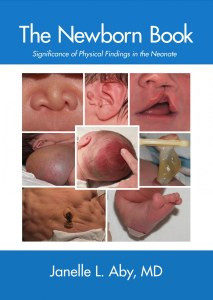Mennonite Health Journal
Articles on the intersection of faith and health
“The Book” on Newborns
Paul D. Leichty
from Mennonite Health Journal, Vol. 17, No. 4 – November 2015
MHF Member publishes neonatal reference book
 While “the story behind the book…isn’t terribly dramatic,” says Dr. Janelle L. Aby, “the bottom line is I wrote the book I wished I owned.”
While “the story behind the book…isn’t terribly dramatic,” says Dr. Janelle L. Aby, “the bottom line is I wrote the book I wished I owned.”
The author isn’t the only one who wishes to own the book. Dr. Aby’s recently published volume, The Newborn Book: Significance of Physical Findings in the Neonate[1] is drawing rave reviews from leading pediatricians and neonatologists not only in the U.S. but also from diverse locations like Switzerland and Nepal. One reviewer said, “I have been board certified in neonatology for over 30 years and this is by far the best done and most extensive collection of newborn images I have seen…. I think this reference is so complete it should replace “Google” for the evaluation of the newborn with an unusual physical finding.”[2]
Janelle Aby is a member of Mennonite Healthcare Fellowship from Santa Clara, California. She has been caring for newborns for more than 20 years and is currently Clinical Professor of Pediatrics at Stanford University as well as Medical Director of the Newborn Nursery at Lucile Packard Children’s Hospital. In addition to her clinical work, she has devoted herself to teaching medical students, nurses, and physicians in the care of newborns. Her teaching work has not only been recognized within the Stanford University School of Medicine but has also helped many other programs around the world through a set of comprehensive online neonatal educational resources at newborns.stanford.edu.[3]
Janelle describes the book as “focused on findings encountered in a presumably ‘well’ baby” which makes it “useful to primary care providers at all levels of training (physicians, nurses, physician assistants, students, etc.).” She continues, “After all these years of working in the nursery, I realized that there was no resource that could answer the clinical questions we often had. The existing textbooks/references were either targeted towards the neonatologist (and therefore focused on serious and life-threatening conditions) or they were discussing the “well baby” population in a very limited way (basically just re-hashing management of jaundice and a couple of the most common rashes).”
Thus she set out to write the book with a four-fold purpose in mind:
- To provide a fairly comprehensive reference that includes extremely common things that no one ever writes about but everyone is expected to know (e.g. self-inflicted fingernail scratches) as well as very rare things that might come through a regular care nursery and get missed or mismanaged because no one has ever heard of them.
- To have the material organized in such a way that it’s “searchable.” She cites the example of seeing a lump on the head of uncertain origin. In such cases, it’s impossible to research the question of how to proceed with a standard textbook. “If you don’t know the name of the condition, how do you know what to look up? Should you pull out a neurosurgery textbook? Dermatology? Neonatology?” In her book, she has grouped the conditions by body part so that someone can flip through the relevant section, looking for something that looks similar to what their patient has and then find a reasonable differential diagnosis. From there, armed with a list of possible conditions, one can start researching online or elsewhere.
- To include both basic and more detailed information on each finding so that the book is user-friendly for people at all levels of training and in all disciplines that interact with newborns (RNs, MDs, PAs, IBCLCs, midwives, etc)
- To use many pictures. She says, “Words can so often mean different things to different people. Even in our current practice, we see evidence of this. The sacral dimple that concerns the neurosurgeon may have no resemblance whatever to the “sacral dimple” that the pediatrician is looking at. Pictures can bring us all onto the same page and can help expand our clinical experience as we are allowed to “see” more conditions than we would in day-to-day practice.”[4]
Indeed, the book is comprehensive and loaded with pictures. Over 250 topics and 600 pictures fill its pages. There is discussion of the background, pathophysiology, risks, clinical appearance, and management of each condition and the book also addresses breastfeeding and lactation management for at-risk mother-baby dyads.
The international appeal of The Newborn Book may be related not only to the depth of Dr. Aby’s knowledge but the breadth of her experience. She cites her Student Elective Term (SET) experience in Swaziland in 1992, as well as a later trip to Papua New Guinea, as having an impact on how she thought about this project.
The Newborn Book: Significance of Physical Findings in the Neonate is available on its own dedicated website at thenewbornbook.org. An ebook edition is also available on Kindle.[5]
[1] See the website http://thenewbornbook.org for more information and documentation.
[2] (Book Reviews, 2015)
[3] In addition to newborns.stanford.edu, Dr. Aby has a blog on the book website at thenewbornbook.org/blogs/book
[4] Purposes outlined in an email to the author, June 4, 2015
[5] See Amazon.com
About the author
 Paul D. Leichty, M.Div. is Executive Director Emeritus, having served as the first Executive Director of Mennonite Healthcare Fellowship (MHF) from Sept. 2011 through May 2020. Paul has served as a pastor, church musician, computer support person, disabilities advocate, and administrator/organizer of a number of church-related ministries. Paul also served as Executive Director of Congregational Accessibility Network which was transformed in 2022-23 to Disability Ministry Network. He is a member of Agape Fellowship of the Mennonite Church in Williamsport, Pennsylvania where he lives with his wife, Twila Charles Leichty.
Paul D. Leichty, M.Div. is Executive Director Emeritus, having served as the first Executive Director of Mennonite Healthcare Fellowship (MHF) from Sept. 2011 through May 2020. Paul has served as a pastor, church musician, computer support person, disabilities advocate, and administrator/organizer of a number of church-related ministries. Paul also served as Executive Director of Congregational Accessibility Network which was transformed in 2022-23 to Disability Ministry Network. He is a member of Agape Fellowship of the Mennonite Church in Williamsport, Pennsylvania where he lives with his wife, Twila Charles Leichty.
